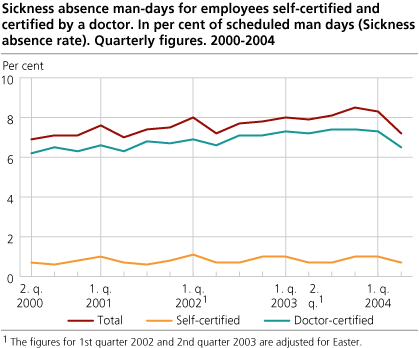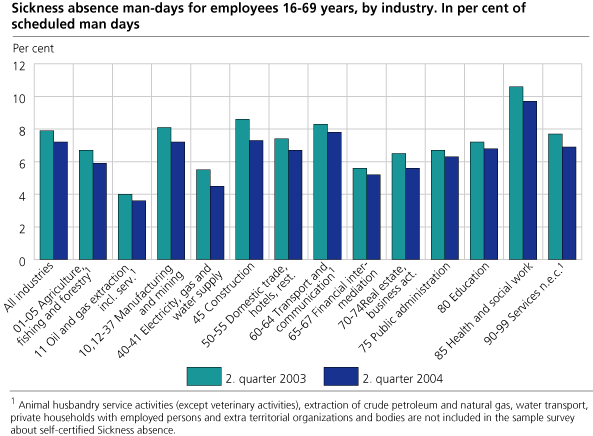Content
Published:
This is an archived release.
Decrease in sickness absence
The total sickness absence fell from 7.9 to 7.2 per cent from the second quarter of 2003 to the second quarter of 2004. Absence certified by a doctor fell from 7.2 to 6.5 per cent, while self-certified absence remained flat at 0.7 per cent.
The sickness absence rate for men fell from 6.4 to 5.8 per cent, and the rate for women fell from 9.8 to 8.9 per cent. For both groups the decrease came in the doctor-certified absence.
Decrease in all major industries
The strongest decrease in sickness absence came in the industry groups construction, manufacturing, business activities and health and social work, whereas the groups oil and gas extraction, public administration and education had the lowest decrease.
The following comments are based on the figures for sickness absence certified by a doctor, which represent approximately 90 per cent of the total absence. The survey on self-certified absence only contains information on industry and gender.
Decrease in all age groups
Among men, the age group 60-64 stands out with a recorded fall in sickness absence of 1 percentage point. Absence among women aged 30-34, a group that has seen a strong increase in absence in previous surveys, also fell by 1 percentage point. In the other age groups the decline was fairly steady and equal for both men and women.
Decrease in all counties
The fall in doctor-certified sickness absence took place in all counties, but was strongest in Hedmark, Oppland, Telemark, Vest-Agder and Nordland. Møre og Romsdal, Sogn og Fjordane and Akershus had the smallest decrease. Despite a smaller than average decline, Rogaland still has the lowest sickness absence rate, at 4.9 per cent. Finnmark continues to have the highest rate, at 8.3 per cent.
Tables:
- Table 1 Sickness absence man-days for employees self-certified and certified by a doctor. In per cent of scheduled man-days (Sickness absence rate). Quarterly figures. 2000-2004
- Table 2 Sickness absence man-days for employees self-certified and certified by a doctor, by sex. In per cent of scheduled man-days (Sickness absence rate). Quarterly figures. 2000-2004
- Table 3 Sickness absence man-days for employees self-certified and certified by a doctor, by industry and type of sickness absence. In per cent of scheduled man days (Sickness absence rate). Quarterly figures. 2000-2004
Contact
-
Arbeidsmarked og lønn
E-mail: arbeidsmarked@ssb.no
-
Unn H. Høydahl
E-mail: unnh.hoydahl@ssb.no
tel.: (+47) 40 90 23 77


